This is a Leica Model A, made by Ernst Leitz GmbH of Wetzlar, Germany. The serial number of this particular camera means it was made in 1930, but the earliest Model As were first introduced in 1925. The Leica Model A is one of the most historically significant cameras ever made, in that it set the standard for how a 35mm camera should operate for the rest of the century and beyond. It defined 24x36mm as the “normal” size for 35mm film, which in turn defined “full frame” digital cameras sold today. Although the Leica camera would evolve far beyond this simple scale focus camera with a collapsible fixed Elmar lens, the Leica Model A is an extremely desirable camera by users and collectors alike.
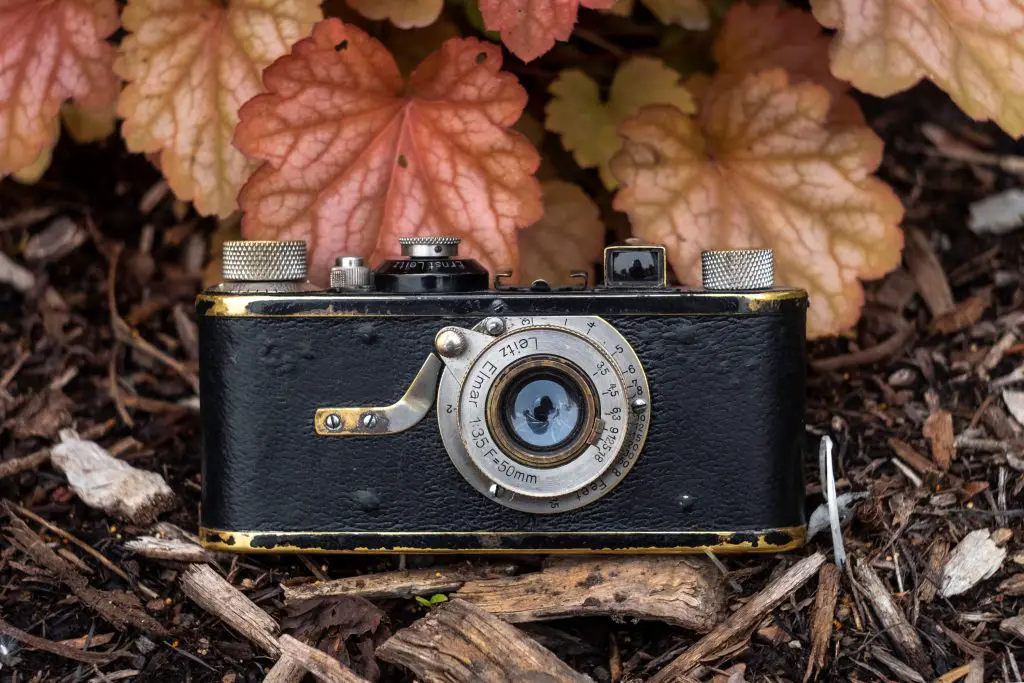 Film Type: 135 (35mm)
Film Type: 135 (35mm)
Lens: 50mm f/3.5 Leitz Elmar uncoated 4-elements
Focus: 1.5 feet to Infinity
Viewfinder: Scale Focus Reverse Galilean
Shutter: Cloth Focal Plane
Speeds: Z (Bulb), 1/20 – 1/500 seconds
Exposure Meter: None
Battery: None
Flash Mount: None
Weight: 420 grams
Manual: https://www.pacificrimcamera.com/rl/00035/00035.pdf
Manual (Alt Version): https://www.cameramanuals.org/leica_pdf/leica_leitz.pdf
How these ratings work |
The Leica Model A is a very basic and early camera that shares much in common with the original prototypes from 1913. Lacking modern conveniences like a rangefinder, interchangeable lens mount, self timer, an exposure meter, or flash synchronization, this camera frees you up to just focus on photography and in that regard, succeeds very well. Shooting this camera is simple and fast, and assuming you use it to it’s strengths, will reward you with some unexpectedly good results. These cameras are old, and not inexpensive, but if you get a chance to buy or shoot one, I definitely recommend it! | ||||||
| Images | Handling | Features | Viewfinder | Feel & Beauty | History | Age | |
| 2 | 2 | 1 | 1 | 2 | 2 | 40% | |
| Bonus | +1 for complete perfection, a 90 year old camera that shoots better than many half it’s age | ||||||
| Final Score | 15.0 | ||||||
Prologue
If you were to take any single product ever made in the entirety of human history and find one that has had more of a greater influence on everything that followed it, you would be hard pressed to find one that had as great of an influence on it’s industry than the first Leica camera.
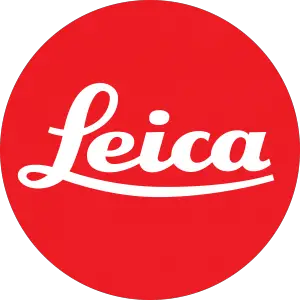 Leica is the brand that has been copied, cloned, mimicked, replicated, and inspired the most out of any single product or maker ever in any industry.
Leica is the brand that has been copied, cloned, mimicked, replicated, and inspired the most out of any single product or maker ever in any industry.
It’s this notoriety that has given Leica a legendary place in the history of photography. Perhaps even more amazing is that their reputation survived two world wars, two German economic collapses, the rise of the Japanese camera industry, the advancement of electronic and CPU controlled cameras, and the digital camera revolution. Leica is still a respected brand, and a name that when mentioned within earshot of any photographer, will cause them to take notice.
You can figuratively throw a rock on the Internet and find some kind of Leica information site on the web. A Google search for “Leica History” will tell you anything you could possibly ever want to know about the Ernst Leitz company, their earliest products, every model they’ve ever made, and how well they’ve done over the past century, so I’ll try not to repeat too much information here.
History
In 1849, German mechanic and mathematician Carl Kellner published a paper describing a new optical formula he had developed in the field of microscopy. His new formula was capable of rendering an image with correct perspective, free of the distortions typical of other microscopes of the time. Herr Kellner went on to start the Optisches Institut in Wetzlar, Germany which was an optical institute that made lenses and other equipment for microscopes.
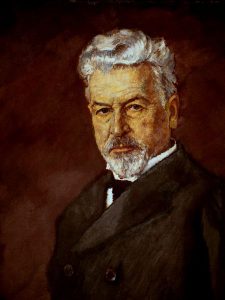
A 21 year old mechanic named Ernst Leitz would move to Wetzlar and become employed at the Kellner Institute in 1864. Leitz had several years of experience making watches in Switzerland, so shortly after starting at the institute, he would be trained as an instrument maker for physical and chemical apparatus.
Leitz must have done a pretty good job, as he was promoted quickly, and in 1869 became the sole owner of the institute, changing the company’s name to Ernst Leitz GmbH.
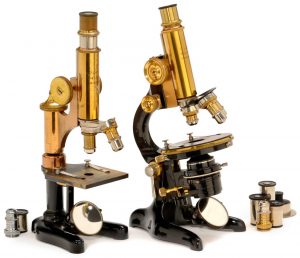
Leitz continued pioneering work in the optics industry, focusing mainly on microscopes for medical use. The company earned a high reputation for well built, quality products. Many of their early products were custom tailored for each customer’s specific needs, assuring that very few of these early microscopes were alike.
The company grew quickly, and by 1887 had produced it’s 10,000th instrument. Within 4 years, that number doubled, by 1899 the 50,000th was made, and by 1907, the Leitz company had made it’s 100,000th microscope.
By the turn of the 20th century, Leitz had a positive world-wide reputation, and had expanded it’s product offerings to more than just microscopes. The company was a pioneer in labor practices, establishing an 8 hour work day, and company sponsored health care for it’s employees.
In 1902, a German mechanic and industrial designer named Oskar Barnack started work for Carl Zeiss in Jena as a precision mechanic. He was well known in the German optics industry and helped Zeiss expand out of optical lens manufacturing into the photographic industry. Another Zeiss employee, Emil Mechau, left Zeiss to work for Leitz in 1908 as there was more creative freedom working for Leitz. Around 1911, upon hearing of his friend’s dissatisfaction working at Zeiss, Mechau recommended to Leitz that Barnack would make a good addition to the company.
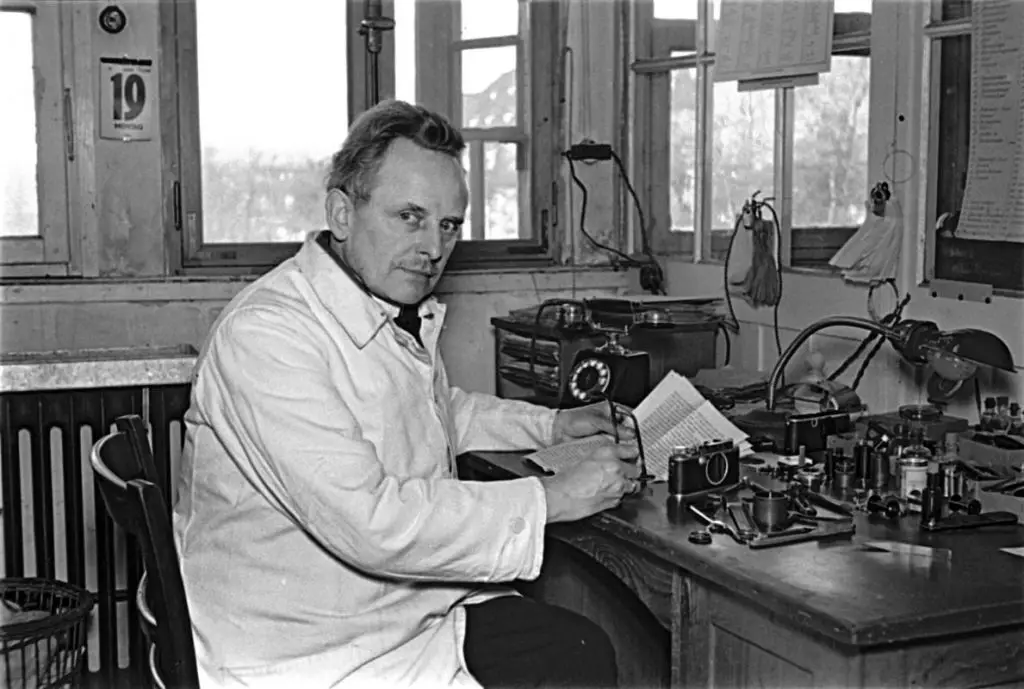
Impressed with his reputation and recommendation by Mechau, Oskar Barnack was recruited by Ernst Leitz to work for him and was offered the head research position for Leitz’s microscope division.
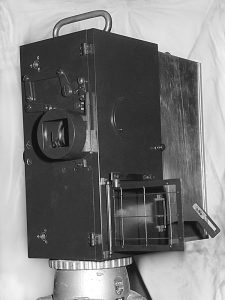
Despite being a skilled mechanic and industrial designer, in his free time Barnack was an enthusiastic photographer. Around 1912, he was tasked to work on a new aluminum bodied motion picture camera that would use 35mm cinema (or kine) film. Oskar Barnack had severe asthma which made him weak, and the aluminum body was chosen to keep weight to a minimum, compared to the heavy wooden cameras of the day.
While working on this new motion picture camera, Barnack often struggled to get the shutter timings right because film emulsions of the day were very inconsistent and often required varying speeds to get the exposure correct. Since cinema film came on very long spools, if the timings weren’t correct, a large amount of film could be wasted if the exposure was incorrect. Barnack set out to develop a type of film tester that would expose a single frame or two of a new roll to test it’s speed, and once he could determine the correct timings for that roll of film, he could calibrate his motion picture camera to expose the rest of the roll consistently.
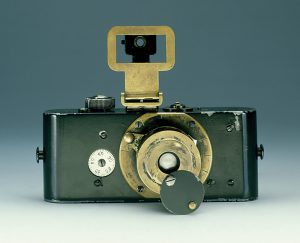
Barnack’s first prototype of his single frame tester was completed in 1913 (some sources say 1912, but I believe 1913 is correct). Upon it’s completion, Barnack’s tester had no official name, but in the years that would pass, this original device earned the name “Ur-Leica”. The prefix “ur” in German means prime, original, or first.
The Ur-Leica was designed to use the same 35mm cinema film that would have been used in cinema cameras, but in order to increase the exposed image size, he made it so the film would travel through the camera horizontally, which doubled the size of the exposed frame resulting in images that were 24mm x 36mm.
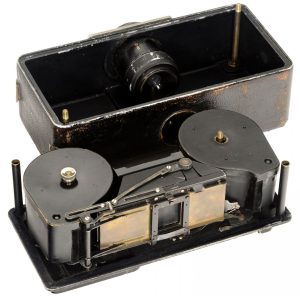
Even though it wasn’t his original intent, the Ur-Leica turned out to be the inspiration for the first Leica still frame camera. By 1913, the idea for a still frame camera that used 35mm cinema film was not new. Prior to Barnack’s tester, other manufacturers such as C.P. Goerz and Ernemann had already designed models that did the same thing. The Herbert & Huesgen Tourist Multiple of 1913 is credited as being the first commercially successful 35mm camera.
There was no set film standard for motion picture film at the time, so early 35mm still frame cameras often relied on paper backed perforated and unperforated motion picture film that was shortened and loaded into custom, hand built 35mm cameras. These cameras fed the film vertically, just like cinema cameras would have, producing an exposed image size of 18mm x 24mm, exactly half of Barnack’s tester.
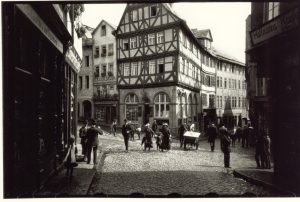
Oskar Barnack was said to be impressed with the images made from the Ur-Leica, and saw the potential for a new type of still frame camera shooting “double sized” 24mm x 36mm images. The camera’s small size meant it would be easily portable, and when combined with a quality lens, would be capable of highly detailed images that would enlargen well. Despite the promise of what a new still camera could offer, the idea to mass produce the camera would not materialize for nearly a decade.
There were multiple reasons for this. The first being that Leitz was a world leader in the microscope industry, and while cameras might have been a logical branch for the company to pursue, it’s demands for current products limited the amount of resources that could be given to a new camera department. But more significant was the onset of World War I in Germany which halted a lot of German industry, and by the end of the war, had decimated the German economy. Further complicating matters, the senior Ernst Leitz would pass away in 1920, and the entire operation of the company would pass onto his second son, Ernst Leitz II.
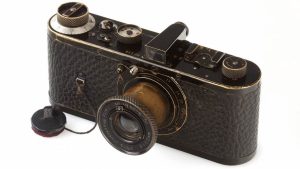
By 1923 however, the Leitz company recovered enough to allow Barnack to convince Leitz II to allow him to use his 1913 prototype to manufacture a limited run of 25 (some sources say 31) cameras that could be given to photographers to test. Although these prototypes were never sold or given any kind of “official” Leica name, in the world of Leica history, these first cameras have become known as the Null Series or sometimes as the Leica 0.
The Null Series cameras must have received enough positive feedback that in 1924, Leitz allowed for a limited production run of 1000 Leica cameras. The name Leica was chosen as a combination of “Lei” from Leitz, and “-ca” from camera. The practice of combining a part of the company name with “-ca” was common in the early years of the Japanese camera industry with names like Yashica, Nicca, and Konica.
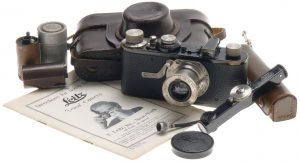
The new Leica camera was revealed in March 1925 at the Leipzig Spring Fair in Germany as the Leica Model A. The camera was an immediate success as it was the first ever compact camera designed for 35mm cinema film made with top notch quality, by a reputable optics company as opposed to some hobbled together model built with questionable quality control standards.
The Leica had a cloth focal plane shutter with speeds from 1/25 – 1/500, a fixed scale focus viewfinder, and a non-removable, but collapsible Leitz 50mm f/3.5 lens. The lenses available on these early cameras changed from a simple Leitz Anastigmat, to an Elmax, finally settling on the Elmar.
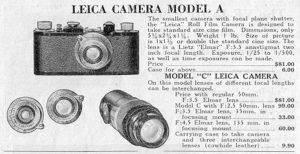
In their 1931 catalog, Burke & James of Chicago advertised the fixed lens Leica Model A for $81. For the same price, you could also get the Leica Model C with it’s interchangeable lens mount and the same f/3.5 Elmar. When adjusted for inflation, this compares to about $1350 today which was not an insignificant price for what was then an unheard of camera that shot on film which hadn’t yet established itself as a professional format of choice.
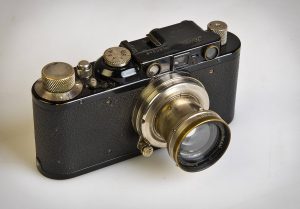
In 1932, an all new model, called the Leica II was released with a coupled rangefinder added to the top of the camera. The rangefinder was not integrated into the main viewfinder, but was instead visible in a second window next to the main viewfinder. Although primitive today, this was revolutionary stuff at the time as most rangefinder aides were auxiliary ones that were used completely separate from the camera, or attached to an accessory port.
Both the Leica I and II were huge successes all over the world. While Leitz had enjoyed a very positive reputation as a leader in the microscope industry, it was the Leica camera that would elevate the company to levels never before possible.
The Leica would continue to evolve with the Leica III in 1933, which added a front-mounted slow speed dial which brought the slow speeds down from 1/25 to a full second. The Leica IIIa from 1935 bumped the top speed up to 1/1000th of a second.
These early Leicas set the standard for the world’s best cameras of the 1930s. Prior to the second World War, Leica had become so synonymous with quality, that many copies, first from the Soviet Union and then eventually Japan and many other countries started to be made. Although the Soviet copies were never branded as actual Leicas, they were very similar.
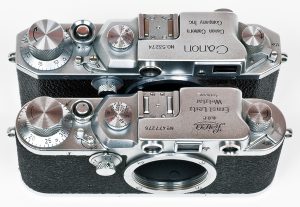
After World War II, all of Germany’s patents became null and publicly available to anyone who wanted a crack at making a camera using any part of the design from a German company. Cameras that ranged from exact copies to those just heavily influenced by the Leica came in many shapes and forms from the Soviet Union, Japan, England, the US, and several other countries.

While most Soviet made Leica copies were nearly identical to the original design, the more successful and better built Japanese Leica copies were heavily inspired by the original Leica, but almost always had something distinctly different. Canon gained their reputation as a quality maker of cameras by first copying the Leica and improving upon it. As the years went on, these original Leica copies would end up developing into their own distinct models that would eventually look less and less like a real Leica.
Thankfully, the area of Germany where the Leitz company was located was in what would become Allied controlled West Germany, and Leitz’s operations were allowed to continue. Despite having all of their designs and patents copied by many companies all over the world, Leitz kept innovating. For the first few years after the war, they would continue to update and improve the pre-war models with new and unique features.

Perhaps due to the widespread use of Leitz’s designs, in 1954 the company would release it’s first completely new camera designed from the ground up. Known as the Leica M3, (there was an M1 and M2, but they came after the M3) this new camera offered a fresh start for the company. The M3 had an all new body with a bayonet lens mount, which would become known as the Leica M-mount. Bayonet mount lenses offer many advantages to screw mount lenses, the most significant being they are faster to attach and detach. The Leica M-mount was so successful that it is still in use today with digital Leica cameras.
Today, Leicas need no introduction. If you’re interested in an early model, you’re more likely to seek out a II or III model, rather than this Model A as they are expensive and very hard to find. My guess is, most collectors who have one in their collection don’t use it, but that’s a shame as this camera, despite it’s age, it still quite capable and a lot of fun to use.
My Thoughts
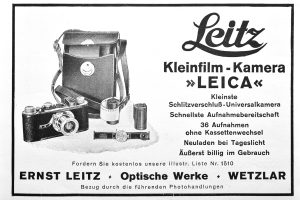
There are those who think that once you’ve shot one Leica, you’ve shot them all as most Leicas are just variations on the same theme. There’s also a whole lot of Leica copies, some of which are very good, so is there really that much of a difference between a genuine Leica III and a Japanese or Soviet copy? Many people will have very passionate responses to that question, so it’s probably smart that I move on quickly from this direction…
Whatever your opinion though, what happens when you get a chance to shoot not only a REALLY old Leica, but one that’s been professionally serviced too? The first commercially available Leicas first went on sale in 1925, and while there were some minor revisions along the way, the earliest Leica Model As are notable as both lacking a rangefinder and also featuring a non-removable lens.
These cameras, for as important as they were, ultimately started off as a film speed tester, created by someone who was trying to build a motion picture camera. So it’s lack of any slow speeds, interchangeable lenses, rangefinder, self-timer, or flash synchronization weren’t a big deal.
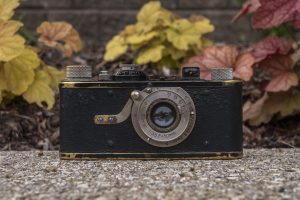
Shooting an old camera is all about the basics. The Leica Model A is about as basic as they come, yet, it was incredibly well made. A camera that inspired a whole industry and was copied more often than probably any other camera ever. What would it be like to shoot a Leica Model A with a serial number that dates it to 1930? I had to find out.
For starters, the Model A is quite small. With the lens collapsed, the camera easily fits in a small purse or medium coat pocket. The entire camera (minus film) weighs a mere 420 grams which is in line with many plastic point and shoot cameras from the 1980s. With the reputation of it’s lens and shutter, being able to shoot good quality “double frame” 35mm exposures in such a small package must have been a huge selling point for photographers back then.
I’ve spoken in other reviews such as the one for the Kodak Retina Ib about how I actually find scale focus cameras to be faster than some early rangefinders as not only are the viewfinders usually larger and brighter, but zone focus usually works well enough for most outdoor scenes and not having to align two images together can actually speed up your process, and that applies to the Leica Model A.
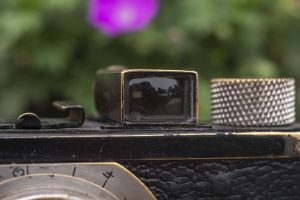
The viewfinder is decently large and very easy to compose with. It’s location on the very shallow top plate is barely an inch from the center line of the lens which means parallax shouldn’t be much of an issue most of the time.

With the exception of the missing rangefinder, the top plate of the Model A should look familiar to anyone who’s seen a Barnack style Leica or one of it’s clones.
From left to right is the film rewind knob, viewfinder, accessory shoe, shutter speed dial, shutter release, film transport lever, and dual advance knob and exposure counter. I should point out that the shutter speed dial is not original to this camera and was replaced at some point in the past. It was likely from a Leica III as it has a selection for 20-1 which is not available on the Model A. The Ernst Leitz Wetzlar ring also looks to have a fresher coat of paint on it than the rest of the camera. I knew this camera was serviced previously, so these parts were likely replaced for some reason.
The Leica Model A is a pretty basic camera, so there’s not much else to see on the back, bottom, or the sides. On the bottom is the 3/8″ tripod socket and standard film compartment release lock. Take a look at all that brassing! So pretty!
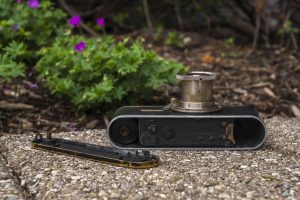
As with all early Leicas, the Model A is a bottom loader which depending on your experience is either a minor annoyance, or a huge deal. I’m in the ‘minor annoyance’ camp as I’ve never really found bottom loading all that difficult. Sure, you need to cut the film leader to make it a little longer (approximately 10cm) but that takes maybe 3 seconds to do with a pair of scissors. I’ve previously typed instructions on how to load film into a Leica in my review for the Leica Ic, so rather than repeat that information here, I recommend checking out that review for instructions how it’s done.
A tip I discovered on accident is that starting with the Leica M3 and other bottom loaders made by companies like Canon, the take up spool was redesigned to be spring loaded. Spring loaded spools are much easier to get in and out of the camera. The Leica part number for their spring loaded spool is SVOOP, but you can use a spool from a Canon or any other bottom loader that has a similar design.
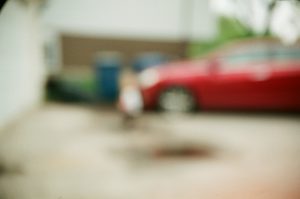
Once you have the camera loaded with film, it’s time to go shooting. The Model A does not have an interchangeable lens, and the one it does have is collapsible, so it’s critical that you remember to extend the lens to it’s fully erect position, otherwise your exposures will be badly out of focus like the one to the right. I found that when I was out with this camera, I would just leave the lens extended the entire time, reducing the number of times I had to remember to extend it.

The hockey stick shaped piece of metal on the front body of the camera serves as the infinity stop. This stop functions whether the lens is extended or not, so it is a good reminder to extend the lens before focusing the camera, since you need to look at it anyway. With the lens in the image to the left, a gently inward press of the top of the “hockey stick” while rotating the focusing arm counterclockwise, allows you to set something other than infinity. The 50mm Elmar has a minimum focus down to 1.5 feet which is less than later Leicas who are rangefinder limited to about 3 feet. Leitz produced these cameras with focus scales in both meters and feet, depending on where it was sold, but could also be converted by the original owners if they wished.
To many people, the prospect of shooting a 90 year old “classic” might be intimidating, but there’s a reason Leica cameras were so successful. They were easy to use, and built to a very high quality standard. With only a quick crash course, I believe anyone could shoot this Model A and get great results. What this camera lacks in features, it more than makes up for in ease of use.
But any camera can be easy to use, but what you really want to know is what kinds of images did it make? Keep reading…
My Results
This camera was a loaner from my friend Ray Morgenweck and I didn’t have as much time as I usually have with other cameras, so I shot two rolls in it back to back. The first was a roll of Kodak Panatomic-X 32 that had expired sometime in the early 1990s, and the second was a fresh roll of Fuji 200. I’ve shot many expired rolls of Kodak’s Pan-X film, some much older than this roll, and no matter how old it is, this film seems to defy aging so I just shot it at box speed.
I enjoy shooting complicated cameras like the Kodak Ektra and Bell & Howell Foton for their complexities and fascinating designs, but each of those cameras often require a refresher of the manual each time you pick them up. Sure, the shooting experiences are memorable, but sometimes you just want to shoot and not be bothered by oddly located controls or other bizarre ergonomic choices.
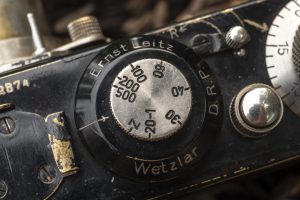
That’s where the Leica Model A shines. Throughout my time with this camera, I often thought about how easy it was to shoot. This particular Leica was made in 1930, and it’s design dates back to around 1913, so you’re talking about a century old device that is faster and easier to shoot than many cameras that were made decades after it.
I am not a Leica-phile. I still do not own a single Leica in my permanent collection. I don’t universally hold the entire lineup in high regard, but I do love this camera. As I already mentioned, it is very small and lightweight. Push in the lens and it easily slides into a pocket. Pull it out (don’t forget to extend the lens) and shoot some candid pictures of people walking around your town, and you won’t ever miss a rangefinder.
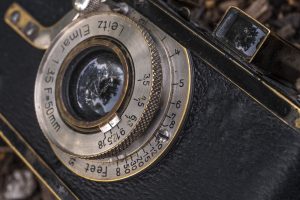
On paper, the uncoated 4-element Elmar f/3.5 lens won’t excite many people, but when looking at the images I got from it, they were excellent. Sharpness was consistent and it didn’t matter whether I was shooting black and white film or color, it handled both films well. The colors on the Fuji 200 were slightly muted, but natural. The Pan-X images had a very faint “glow” to them that many people say is characteristic of this lens. It’s not haze as the Elmar lens on this camera was crystal clear.
Images shot with this camera have character, and combined with a convenient size and great ergonomics, made for an awesome shooting experience. It’s easy to declare the success of the Leica camera a result of good build quality, it’s lenses, or even just releasing the right product at the right time, and all three of those things are true. But for me, the best thing about this camera is how right Oskar Barnack got it on his first try.
I’ve never put a Leica II or III very high on my wish list of cameras, but if another Model A ever passes in front of my nose at anything resembling a reasonable price, it will be very difficult for me to pass it up, as it should be for you too!
Related Posts You Might Enjoy
External Links
https://www.cameraquest.com/leicaa.htm
http://camera-wiki.org/wiki/Leica_A
https://www.shutterbug.com/content/leica-i-camera-change-photography

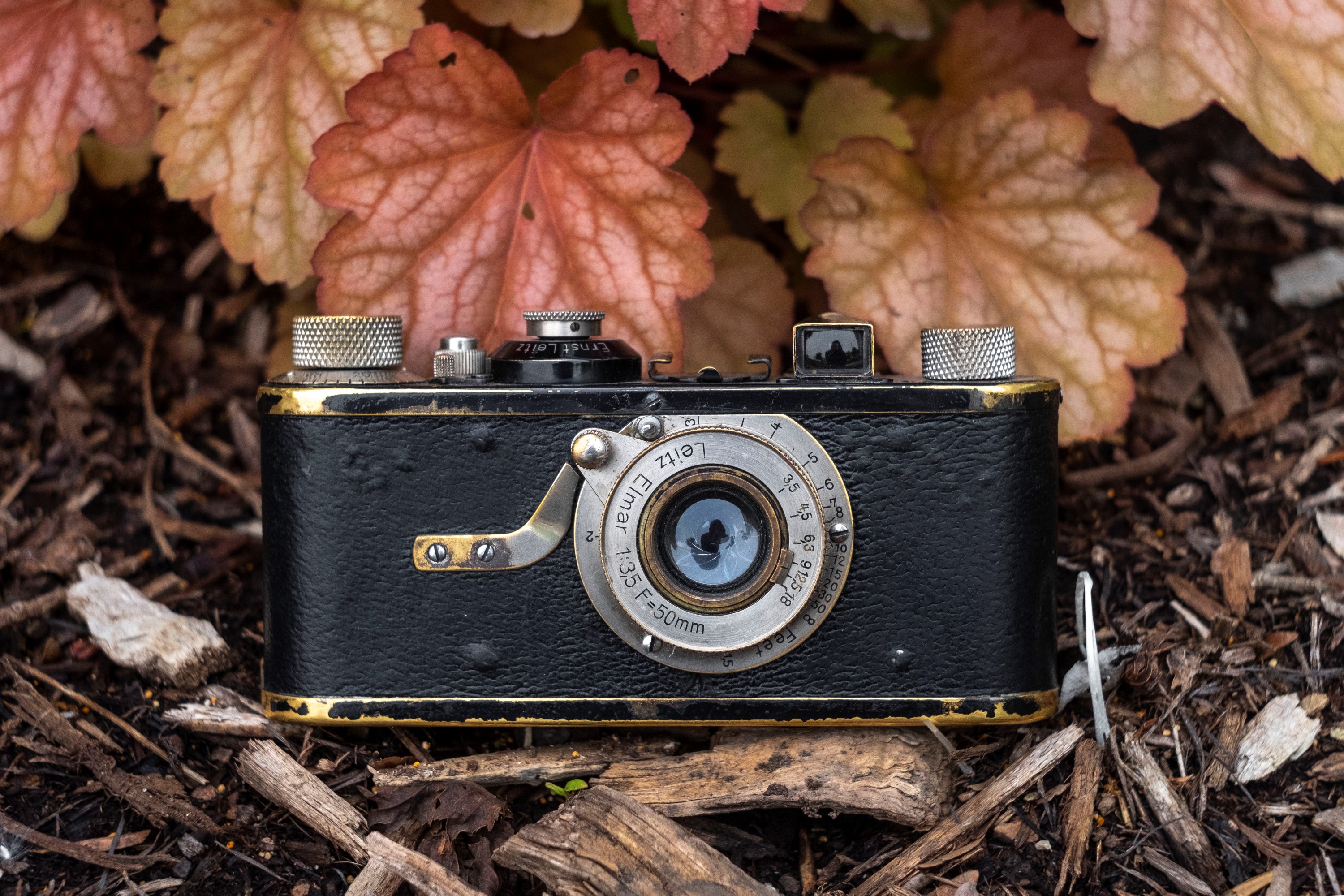
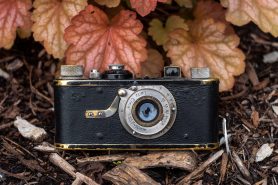
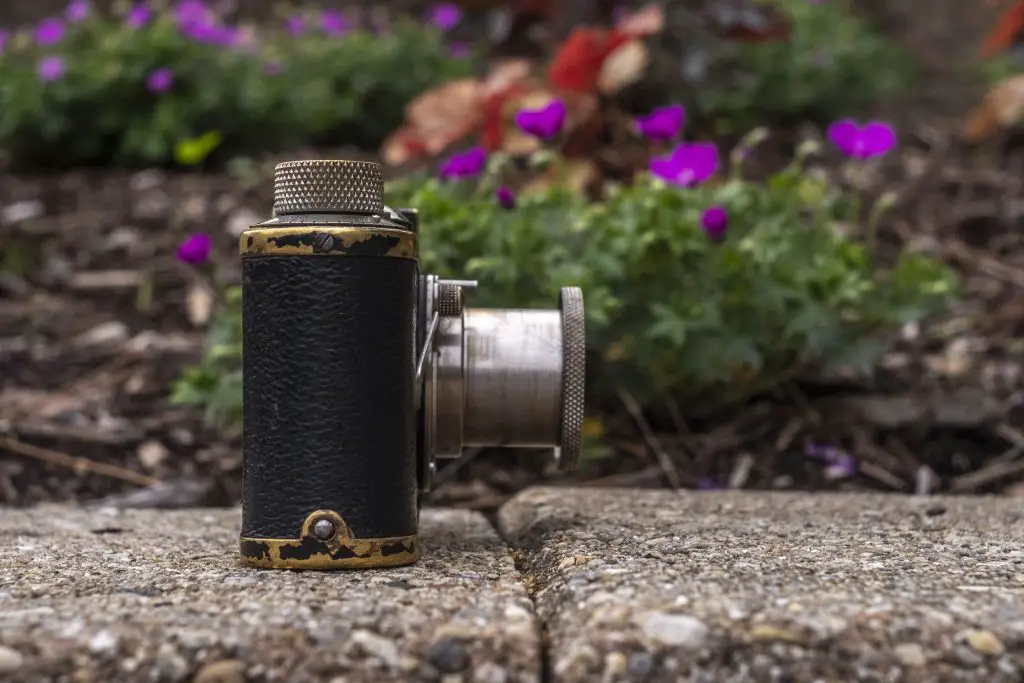
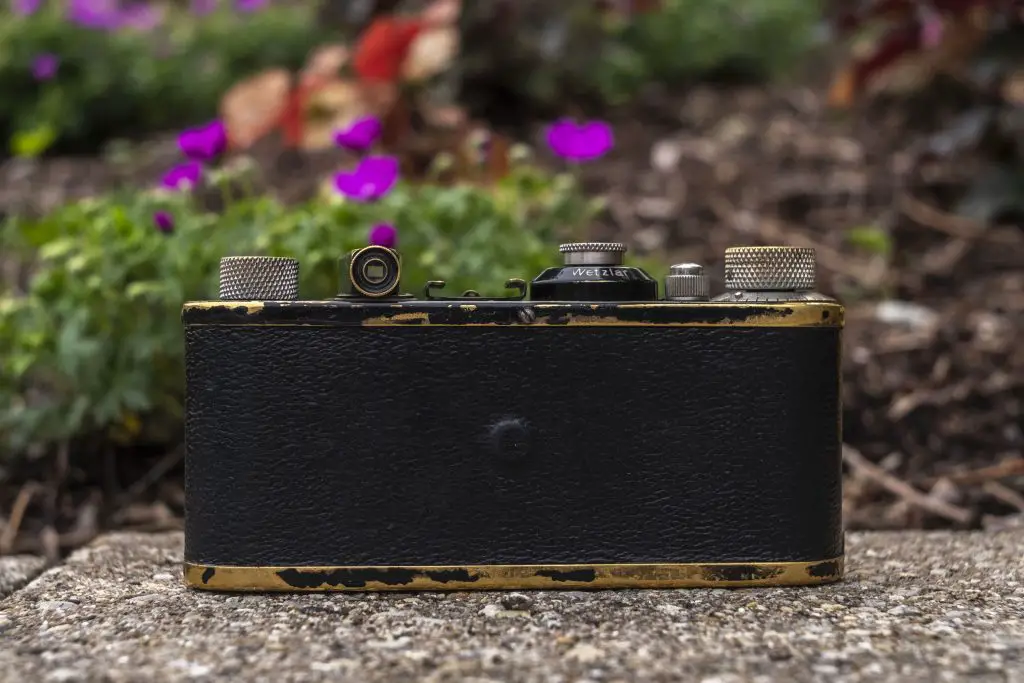
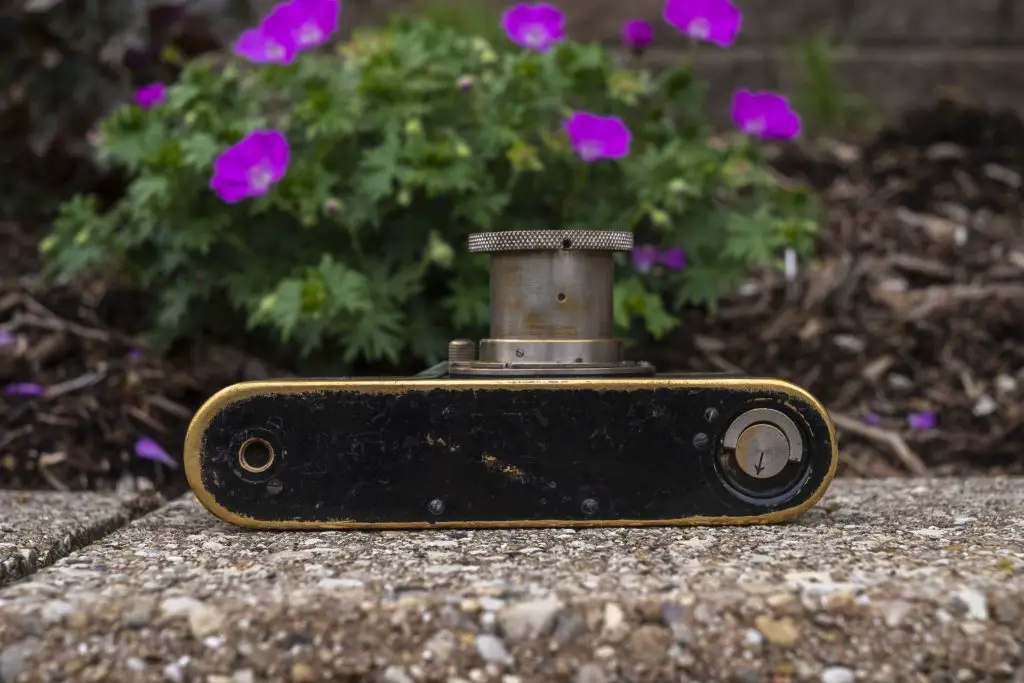





























Excellent!
Very interesting post, Mike – thank you! That “hockey stick” infinity stop is similar to ones found on Ihagee Parvolas and the original VP Exaktas (the ones that shoot 127 rollfilm).
The family’s Leica IIIa was my first serious camera that I started using in the late 1950’s/early 1960’s. A Selenium cell General Electric light meter was an a welcome companion when the film box exposure guide didn’t match the prevailing conditions. Family lore has it that this Leica was bought in post-World-War-II Wisconsin, during the great “camera famine.” The 50mm f/1.5-9 Taylor-Hobson Xenon was OK as long as you “kept the sun at your back,” since this uncoated, pre-war, “speed lens” turned into a “flare-ridden” disaster that was “soft on details.”
This gale-force paper weight was retired once I bought a 1950’s-vintage 50mm f/3.5 collapsible Elmar. As a “modern mono-coated lens,” it produced song-worthy Kodachrome slides and crisp black-and-white prints. Is there something special about a “Barnack” Leica? No more than a contemporary 35mm rangefinder camera, but it is a “complete package” of controls and mechanisms. Until Fujifilm introduced the short “Fuji tongue,” every roll of 135 film had a “Leica tongue” or a perforation in the film sprocket area to show where to cut the “Barnack Leica tongue.”
I have/had considered adding an M-series Leica to the collection, but the Canon P is a (pretty good) substitute.If I wanted a “quick lens change” system, Ye Olde Nikkormat could go wider and longer than a non-Visoflex-equipped M-series Leica. As for Leicaflex, I eventually settled on a Nikon F2, instead. Still, Leica is/was a “magic name” brand during the heyday of Eastman Kodak and analog film. This post reminds me of Jason Schneider’s “The Camera Collector” column and the Leica system books of James Lager. I wonder if this “magic aura” is settling around Fujifilm’s X-series cameras these days?
Thanks for the feedback Patrick! I have also noticed that earlier sub f/2 lenses aren’t always all that their cracked up to be. I was surprised at how soft the Nikkor 50/1.4 lens was on my Nikon rangefinder wide open. It’s fine stopped down, but those earlier lenses definitely don’t hold a candle to later, slower lenses.
I am a big fan of Jason Schneider’s Camera Collector column and often use them as research on many of my reviews. I have access to all of the old Modern Photography magazines from that era when he was writing those. I wonder if he is even still alive?!
As for Jim Lager, you might be interested to know that I have collaborated with Jim a number of times, including this article. I sent him a link as soon as it was posted and he told me he was very happy with it!
I ran across a Jason Schneider “decrepit/classic cameras I have known” article at shutterbug.com. He was still posting articles at that site last year as a sprightly 70-year-old. Although “Jason Schneider” isn’t a common name, an ordinary Google! search will turn up information/web pages on much younger folk. Good luck on your Interweb search.
A search for Ilford’s oustandingly interesting ad campaign of the 1970’s (or was that the 1980’s?), formally introducing the “peaches and cream” to “Nubian Princess” exposure latitude of FP4 yielded nothing. (It featured two female models, one White, one Black, with the “Black and White is Coming to America!” tagline.) Yes, there was a time when Ilford black-and-white film wasn’t officially available at say, “C&I Photo,” or your local camera store. (Freestyle Sales Co. had Ilford FP3 and HP4 if you looked hard enough.)
This doesn’t help my current situation of never having shot a Leica and resisting the idea that I might like one (for reasons I don’t know).
Regarding your results and final thoughts, I think there is something to be said for very basic no nonsense cameras; I recently shot with a Kodak 35 which is similarly basic and I didn’t expect to enjoy it at all but the opposite was true. I found that I just blasted through the roll and it was a nice experience. I think you are right with what you hint at, removing the pressure of ensuring spot on focus etc allows you to just shoot. The resulting shots on the Kodak weren’t as good as your Leica one’s above (it needs a good clean more than likely) but I still enjoyed shooting this 80 year old device.
Thanks for sharing this Leica experience.
I have definitely noticed a trend over the years of shooting so many different cameras, that simpler cameras are often more fun. I echo your praise for the Kodak 35 as I really enjoyed shooting mine. They are susceptible to sticky shutters which do need to be flushed to work correctly, but if you can find a good example of the Kodak 35, it is a really great shooter, that if I’m being perfectly honest, isn’t much different than this Leica Model A!
I have a Leica II or as it was called in the US, a Model D. With a 50mm focal length lens from the 1950’ies, the Model D can still rival many more modern 35mm offerings in image quality – but more importantly, the camera is still fully functional after nearly 90 years. Judging from your photos, the Model A you were using seems to be going pretty strong. The hood and headlights of the Buick Special were rendered quite well.
A morning or afternoon walkabout with a scale focusing 35mm camera, (hopefully one that has a decent lens and all the basic controls), can feel a bit liberating – especially after using a modern, electronic menu operated Sony digicam. At least that is my experience with a Voigtländer Vito II 35mm folder and Rollei 35S with its collapsible Sonnar. The photos from both cameras have always been impressive.
Many years ago, an elderly acquaintance gave me her Leica Model A. It had seen a lot of use, and I imagine it had taken a lot of photos, too. I had it for several months, and I never really warmed up to the camera. I sold it in eBay and that paid for summer camp for my daughter as well as a Nikon F2 for me. At the time, I thought an Argus C3 was the better camera!
I was so glad to discover this great article on a wonderful camera. Thanks so much.
In general, Barnacks (Leicas and copies) are my favorite cameras.
Which camera is my favorite to shoot? It’s too hard to compare so I will pick my 2 favorites.
Leica A
Fuji 617
Quite a bit of difference but both are great fun.